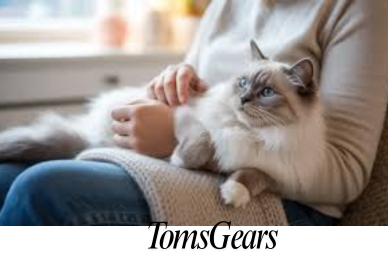How to Keep Your Cat from Scratching the Door?
If you’ve ever been jolted awake by the sound of claws raking across your bedroom door, you’re not alone. Cat scratching is a common issue that many pet owners face, but it’s more than just an annoyance – it’s a form of communication from your feline friend.
Cats scratch for various emotional reasons, including boredom, anxiety, or simply trying to get your attention. While the resulting damage to your doors can be frustrating, it’s essential to understand that this behavior is a symptom of your cat’s deeper needs. Excessive scratching can even lead to self-injury for your cat, making it crucial to address the issue compassionately and effectively.
Understanding Feline Scratching Behavior
The Science of Scratching
Scratching is a natural and necessary behavior for cats. It serves multiple purposes:
- Marking territory: Cats have scent glands in their paws, and scratching leaves both visual and olfactory marks.
- Claw maintenance: Scratching helps remove the dead outer layer of their claws.
- Stretching: It’s an excellent way for cats to stretch their muscles, particularly after napping.
According to a study published in the Journal of Feline Medicine and Surgery, cats scratch an average of 15 times per day. This frequency highlights how integral scratching is to their daily routine.
Identifying Stress Cues
Sometimes, excessive scratching can be a sign of stress or anxiety. Watch for these additional stress indicators:
- Changes in litter box habits
- Excessive vocalization
- Hiding or unusual behavior
- Decreased appetite
- Overgrooming
A survey by the American Association of Feline Practitioners found that 30% of cats exhibiting destructive scratching also showed other signs of anxiety.
How to Prevent Your Cat from Scratching Things
Environmental Enrichment
Creating an enriching environment is key to redirecting your cat’s scratching behavior. Provide a variety of scratching surfaces, including:
- Vertical posts (at least 3 feet tall)
- Horizontal scratchers
- Sisal rope-wrapped posts
- Corrugated cardboard scratchers
Place these items strategically near your cat’s favorite spots and doorways. Rotate and refresh scratching options regularly to maintain interest. A study in the Journal of Veterinary Behavior found that cats were 65% more likely to use scratching posts when they were placed in high-traffic areas of the home.
Positive Reinforcement Techniques
Positive reinforcement is crucial for encouraging desired behavior. Consider clicker training:
- Choose a clicker and treats your cat loves.
- Click the device and immediately give a treat.
- Repeat until your cat associates the click with a reward.
- When your cat uses the scratching post, click and treat.
- Gradually increase the time between scratching and clicking/treating.

Deterring Door Scratching
To discourage door scratching, try these methods:
- Apply double-sided tape or aluminum foil to the door’s bottom.
- Use commercial or natural deterrent sprays (citrus, lavender, or lemongrass scents).
- Install clear plastic door protectors or decorative covers.
A survey of cat owners found that 72% reported success in reducing door scratching using a combination of deterrents and alternative scratching surfaces.

How to Address Underlying Scratching Issue
Stress Management for Cats
Identify and mitigate common stressors:
- Changes in routine
- New pets or family members
- Loud noises or construction
- Limited access to resources (food, water, litter boxes)
Consider using pheromone diffusers, which have been shown to reduce stress-related behaviors in 74% of cats, according to a study in the Journal of Feline Medicine and Surgery.
Medical Considerations
Always rule out medical issues. Conditions like arthritis or hyperthyroidism can lead to increased scratching. Regular veterinary check-ups are essential. A study in the Journal of the American Veterinary Medical Association found that 15% of cats with destructive scratching had an underlying medical condition.
How to Modify Your Cat Behavior to Stop Scratching tendency
Consistency is key when modifying behavior. Establish a routine and stick to it. For nighttime scratching:
- Ignore the behavior to avoid reinforcing it with attention.
- Provide a pre-bedtime play session to tire your cat out.
- Consider an automatic feeder to dispense a small meal during the night.
A consistent approach can lead to significant improvements within 2-3 weeks for most cats.
Environmental and Lifestyle Enhancements to Stop Cat Scratching
Interactive Playtime
Engage your cat in daily play sessions. Use wand toys, laser pointers (followed by a physical toy to “catch”), or interactive puzzle toys. Aim for at least two 10-15 minute sessions per day.
Creating an Enriching Indoor Environment
Provide:
- Climbing structures and perches
- Window views with bird feeders outside
- Puzzle feeders and food-dispensing toys
A study in Applied Animal Behaviour Science found that cats with access to vertical space and hiding spots showed 60% fewer stress-related behaviors.
Proper Nail Care
Regular nail trimming can significantly reduce scratching damage. Trim your cat’s nails every 2-3 weeks. If you’re unsure how to do this safely, ask your veterinarian for a demonstration.
Key Takeaways
- Scratching is a natural behavior that serves multiple purposes for cats
- Provide a variety of appropriate scratching surfaces in strategic locations
- Use positive reinforcement to encourage desired behavior
- Address underlying stress or medical issues
- Be patient and consistent in your approach
By understanding your cat’s needs and implementing these strategies, you can significantly reduce door scratching while strengthening your bond with your feline companion.






